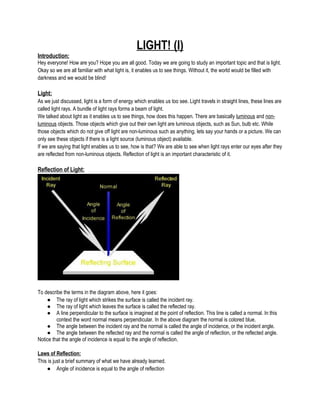
Light i
- 1. LIGHT! (I) Introduction: Hey everyone! How are you? Hope you are all good. Today we are going to study an important topic and that is light. Okay so we are all familiar with what light is, it enables us to see things. Without it, the world would be filled with darkness and we would be blind! Light: As we just discussed, light is a form of energy which enables us too see. Light travels in straight lines, these lines are called light rays. A bundle of light rays forms a beam of light. We talked about light as it enables us to see things, how does this happen. There are basically luminous and non- luminous objects. Those objects which give out their own light are luminous objects, such as Sun, bulb etc. While those objects which do not give off light are non-luminous such as anything, lets say your hands or a picture. We can only see these objects if there is a light source (luminous object) available. If we are saying that light enables us to see, how is that? We are able to see when light rays enter our eyes after they are reflected from non-luminous objects. Reflection of light is an important characteristic of it. Reflection of Light: To describe the terms in the diagram above, here it goes: ● The ray of light which strikes the surface is called the incident ray. ● The ray of light which leaves the surface is called the reflected ray. ● A line perpendicular to the surface is imagined at the point of reflection. This line is called a normal. In this context the word normal means perpendicular. In the above diagram the normal is colored blue. ● The angle between the incident ray and the normal is called the angle of incidence, or the incident angle. ● The angle between the reflected ray and the normal is called the angle of reflection, or the reflected angle. Notice that the angle of incidence is equal to the angle of reflection. Laws of Reflection: This is just a brief summary of what we have already learned. ● Angle of incidence is equal to the angle of reflection
- 2. ● Incident ray, reflected ray and normal lie in the same plane. As shown above, the man and the ball are reflected in the mirror. The image formed in the mirror has certain characteristics: ● it is of the same size as the object ● it undergoes lateral inversion (your left arm will be your right arm in the reflected image) ● it is upright ● it is virtual as it is not formed on a screen ● the distance of the image from the mirror is equal to the distance of the object from the mirror We have all probably noticed these things in our daily lives, after all we stand in front of the mirror everyday! Now, how to draw the ray diagram for the reflection of objects in plane mirror. It’s easy, let’s get started! Now here’s the arrow which we have to reflect in the mirror. How will the eye view the image? Only if the reflected light ray enters the eye. Firstly, draw the arrow in the mirror (on the opposite side of mirror line). Where should it be? We have just learned that the reflected image is the same distance from the mirror as the object is from the mirror. So now draw the arrow like this: Secondly, join one end of the image to the eye.
- 3. Remember to draw the arrow head in the right direction. The light ray is going into the eye, so the arrow will be toward eye. Now, the point where the joined line cuts the mirror, draw the line from the extreme till there. Repeat it with the other extreme end of the arrow. Now, the lines in blue are incident rays while those in red are reflected ones.